Stock Diversifiers: Treasury vs Corporate Bonds?
Tagged:Investing
/
MathInTheNews
/
Retirement
/
R
/
Statistics
If you invest in US stocks, you certainly want to diversify with some bonds for risk control, availability of funds for rebalancing, and earning some income. Should you use Treasury bonds (which earn approximately nothing, but are safe) or corporate bonds (which earn something, but are riskier)?
Why bonds at all?
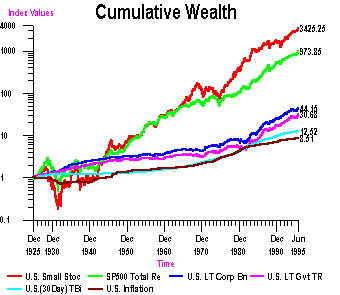 There’s a well-known plot that gets shown to beginning investors, to induce thought about
the long term, and to overcome reluctance to invest in stocks. Here’s a version from a
web site of Prof. Campbell Harvey, of Duke.
Note the vertical log scale: from 1926 - 1995,
stocks returned hundreds of times more than bonds. Today, the case for stocks sounds even
more convincing, since bond yields are so low following the 2007 - 2008 financial crisis.
(And really: negative in real terms, after inflation.)
There’s a well-known plot that gets shown to beginning investors, to induce thought about
the long term, and to overcome reluctance to invest in stocks. Here’s a version from a
web site of Prof. Campbell Harvey, of Duke.
Note the vertical log scale: from 1926 - 1995,
stocks returned hundreds of times more than bonds. Today, the case for stocks sounds even
more convincing, since bond yields are so low following the 2007 - 2008 financial crisis.
(And really: negative in real terms, after inflation.)
So why have any bonds at all?
The answer is 3 things: risk control, rebalancing, and maybe a little income. Yes, a lot of stock will raise the mean value of your portfolio. But it will also increase the probability you go broke! All it takes is one bad recession, combined with job loss or a medical problem (under the cruel US healthcare system), and you suddenly find yourself 50ish, sick, and broke.
If you have some bonds, then you can (a) preserve some capital from the cruel market standard deviation (risk control), (b) have some bonds to sell into a decline to maintain a constant stock/bond ratio (rebalancing), and (c) maybe get some interest paid for your trouble.
So that’s my model: those 3 factors, in that order, motivate me to hold a 60/40 portfolio (60% stocks from all over the world and 40% bonds).
Ok, but can I at least pick some high-return bonds?
People who invest in a lot of stock index funds often look at bond index funds somewhat grudgingly. They figure they’re giving up a lot of return, so want to demand that the bonds pay their way. Treasury bond rates are so low, they sort of want to load up on corporate bonds instead.
Our research question for today is whether that’s a good idea.
Given that I primarily want bonds for risk control and rebalancing, basically diversifying away some of the risk of the stock market, I’m guessing that the answer is no. If you want more return, adjust your asset allocation to include more stock: take your risks on the stock side, not the bond side.
That’s my intuition, but what do the data say?
Available data
Bogleheads.org is a web site/discussion group for followers of John Bogle, the founder of Vanguard and the first to make index funds a reality for ordinary investors.
They’ve done a great deal of work assembling data the historical returns of a wide variety of asset classes. [1] What’s more, they’ve extended the index fund returns into the past using historical indices, and corrected them to account for index fund expense levels. So they look just like something you could actually buy as an investment.
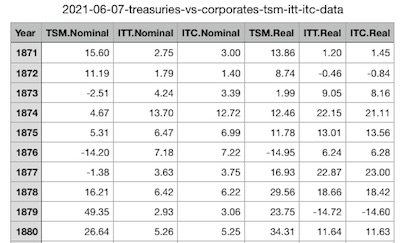 We snapshotted that data for analysis with an
R script. [2] The resulting
dataset contains returns from 1871 - 2020, for the total stock market (TSM), intermediate
term treasuries (ITT), and intermediate term corporates (ITC) on both nominal and real
(adjusted for inflation) terms. [3]
We snapshotted that data for analysis with an
R script. [2] The resulting
dataset contains returns from 1871 - 2020, for the total stock market (TSM), intermediate
term treasuries (ITT), and intermediate term corporates (ITC) on both nominal and real
(adjusted for inflation) terms. [3]
Pre-specified tests
Like good little statisticians, we should pre-specify the analyses we’re going to do, what they mean, and what it would take for them to come up positive and answer the question. (And, though the dataset contains both nominal and real returns, only the latter really matter. So we’ll focus on real returns only.) Our pre-specified statistical tests are:
- Correlations: We’ll measure the Pearson correlation of stock returns vs corporate bond returns, and between stock returns vs Treasury returns. We expect that the Treasury correlation with stocks should be lower, and hence a slightly better diversifier, because corporate bonds contain some corporate stock-like risk. We’ll assess the statistical significance of any such difference by taking the Fisher Z transform of the difference in correlations, and getting a 1-tailed p-value from the normal CDF. If p≤0.05, we’ll buy the alternative hypothesis that Treasuries are better. Otherwise, we will accept the null hypothesis of no such evidence.
- Scatterplots: We’ll also scatterplot the ITC return vs ITT and TSM in 3 dimensions, and see if the visible structure reflects what we conclude from the correlations. This is visual, not quantitative.
- Regressions: We’ll also perform some linear regressions of ITC on ITT and TSM.
First we’ll do LASSO-regulated regression with
glmnet()to see if use of both ITT and ITC as predictors is justified. If so, we’ll compare the regression model obtained there with a more ordinary least squares model, in terms of coefficient sizes. In order to believe that the model is signficant, we’ll demand (a) thatglmnet()not reject either ITT or ITC, (b) that the overall F-statistic of the regression be significant, and (c) that the t-statistic for the TSM term be significant, indicating that it’s really contributing something. - Starting point sensitivity: We’ll repeat this analysis for more recent data, e.g., 1980 - 2020, since the US economy a century ago was very different. Also, we’ll assess whether the p-values change with a start date from 1970 - 1990, going up to 2020. That will tell us if any recent changes in the behavior of bonds have figured in the result.
If all of that checks out, then we’ll believe that corporate bonds are a bit like corporate stocks, and hence are not the best tool to diversify away stock risk.
Analyses
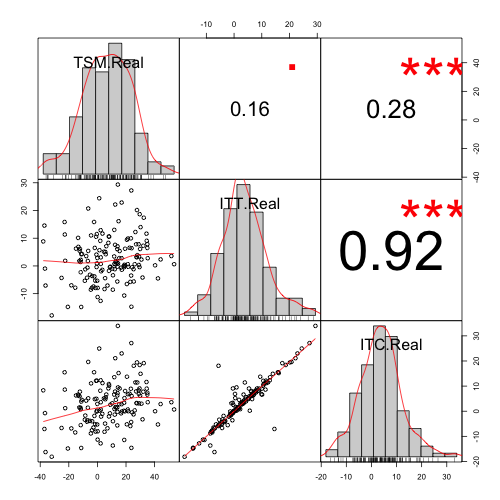 Here’s what the correlations among these 3 variables look like:
Here’s what the correlations among these 3 variables look like:
- First, note on the center right and center bottom that intermediate-term Treasuries (ITT) and intermediate-term corporates (ITC) are very, very highly correlated. They’re both bonds, so that makes sense.
- Second, note on the center left and bottom left the scatterplots of total stock market (TSM) vs ITT and ITC. Both show very little relationship, which is exactly what we want: a good diversifier with stocks will be not very correlated with stocks.
- Third, note at the top center and top right that the correlations of ITT with TSM and ITC with TSM are 0.16 and 0.28, respectively. These are fairly small as these things go, which is just reinforcing what we saw in the scatterplots.
Finally, let’s assess the significance of 0.28 vs 0.16 with a Fisher Z transform. Transform each correlation Ri by:
Zi=12ln(1+Ri1−Ri)Then we compute an overall Z score by:
Z=|Z1−Z2|√N−32That gets us a p-value via the standardized normal CDF. (This is the method used by the function
paired.r()
in the psych library
in R.)
This gives us Z=1.09 and p=0.14. So this difference is not statistically significant. (Came as a surprise to me! But… that’s how you learn things.)
Next is the 3d scatterplot. (My animated graphic software is a bit wounded right now, so this is a kludge for which I apologize.) You can pretty well see that ITT and ITC real returns are highly correlated (lying in a plane), but that neither is much correlated with TSM. This confirms the result above.
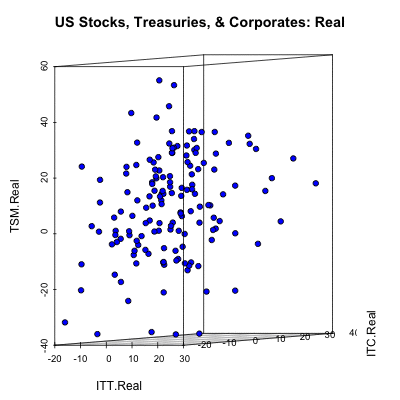
The last analysis here is to do a regression model:
ITC.Real=β0+β1×ITT.Real+β2×TSM.Real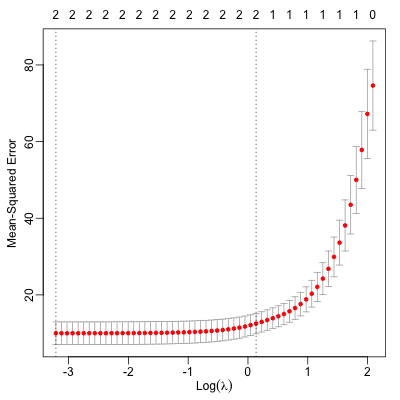 Now, first we use
Now, first we use glmnet() to do a LASSO-regularized
regression. This imposes an L1 penalty parameter λ which, the larger it gets,
the more varibles it suppresses and insists on a simpler model. Here we start with 2
predictor variables (ITT.Real and TSM.Real). We want to know if we really need them both
or if we can dispense with one or the other.
In the plot, we see values of log(λ) along the horizontal axis, and the
mean-squared error of the resulting model under 3-fold crossvalidation on the vertical
axis. Along the top of the plot is the number of predictors retained (mostly 2, then
eventually 1). The moral here is that the very best predictor (vertical dotted line at
the left) uses both ITT.Real and TSM.Real. In fact, the simplest model that is within 1
standard error of this MSE (vertical dotted line at the right) still does that.
Basically, glmnet() is telling us that it would be a gross mistake not to use both ITT.Real
and TSM.Real to predict ITC.Real.
The coefficients used in both of those glmnet() models are similar to the simple linear
regresson model we get with lm():
Coefficients:
Estimate Std. Error t value Pr(>|t|)
(Intercept) -0.17198 0.29205 -0.589 0.557
ITT.Real 0.94562 0.03109 30.419 < 2e-16 ***
TSM.Real 0.06585 0.01437 4.584 9.68e-06 ***
---
Signif. codes: 0 ‘***’ 0.001 ‘**’ 0.01 ‘*’ 0.05 ‘.’ 0.1 ‘ ’ 1
Residual standard error: 3.14 on 147 degrees of freedom
Multiple R-squared: 0.8736, Adjusted R-squared: 0.8719
F-statistic: 507.9 on 2 and 147 DF, p-value: < 2.2e-16
This says the regression’s F-statistic p-value is insanely significant, as is the t-statistic for β2 on TSM.Real, at 9.68×10−6.
Of the pre-specified tests above, we’ve passed all except the demand that the correlations of ITT and ITC with TSM be statistically significantly different. That suggests this test is more stringent than the others, or that there is an artifact of the time window chosen (1871 - 2020) that is suppressing significance here. Let’s investigate that next.
Analyses using just recent data
In the Bogleheads Discussion Group, there is a gentleman using the cognomen of ‘nisiprius’. Whenever anyone makes a claim about investing data from a particular time series, he wanders by to challenge the endpoints. “Does your conclusion hold if you wiggle the endpoints a couple years either way? How about if you take rolling 20-year periods, does it hold all the time then?” He’s always right to do this. So let’s get out ahead of him, and proactively do the right thing here.
The thing about looking back to 1871 is that you are not only constructing artificial data based on questionable indices, but you’re also looking at a very different world in the US. There was no Federal Reserve. Thre was no Securities & Exchange Commission, and indeed no meaningful regulation or enforcement of law in securities trading. There was a gold standard for the dollar, with all the crazy bouts of depression and deflation that brings. There was no anti-monopoly law (though, to be sure, there’s very little left of that nowadays, either). It was, to use a phrase popular with Americans, “the Wild West”.
So maybe data that far back is from a different financial universe. Let’s just consider the data from, say, 1980 - 2020 as representative of the modern financial universe. (And yes, nisiprius, we will consider alternatives even to that, below.)
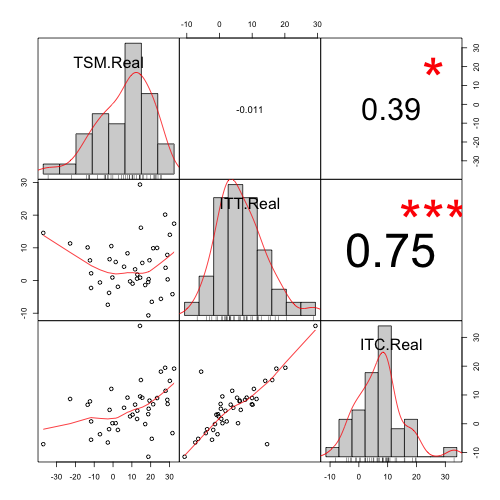
- We see that ITT and ITC are still correlated with each other (unsurprising, they’re still both bonds), though not quite as highly. Some of the loss of correlation might make one a better stock diversifier than the other.
- But we see a surprising difference: the correlation of Treasuries with stocks is -0.01, while corporate bonds have a correlation of +0.39! Repeating the Fisher Z-transform analysis of above, this gives Z=1.83 with a p=0.034. Now… that’s statistically significant!
Clearly, something is different in the modern era that makes corporate bonds more correlated with stocks than Treasuries, or at least more so than formerly.
The scatterplot is, as above, more difficult to interpret. Clearly ITT and ITC are correlated (nearly in a plane together), but the degree of relationship to TSM is hard to assess. This is why we prefer quantitative statistics to visual judgements.
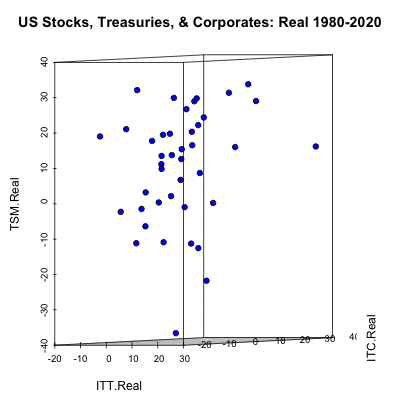
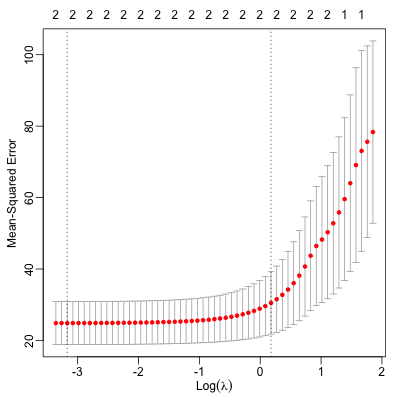 The
The glmnet() LASSO regulated regressions show the same kind of result as above: both ITT
and TSM are essential for predicting ITC. Corporate bonds still have some stock-like
aspects. The very best predictor model (the dashed vertical line at the left) uses both
ITT and TSM as predictors. The simplest model that is within 1 standard error of the MSE
of the best model (the dashed vertical line at the right) also uses the same 2 variables.
Note that the λ parameter, which imposes the L1 penalty, is 3 orders of
magnitude higher, i.e., we’re putting 1000x times more pressure on the model to give up a
parameter, but it refuses. It really, really believes that corporate bonds have
stock-like risk characteristics!
But consider also what happens to the regression coefficients in modernity vs the whole time series:
Coefficients:
Estimate Std. Error t value Pr(>|t|)
(Intercept) -0.12055 0.94350 -0.128 0.899
ITT.Real 0.80151 0.09057 8.850 9.09e-11 ***
TSM.Real 0.21179 0.04582 4.622 4.29e-05 ***
---
Signif. codes: 0 ‘***’ 0.001 ‘**’ 0.01 ‘*’ 0.05 ‘.’ 0.1 ‘ ’ 1
Residual standard error: 4.636 on 38 degrees of freedom
Multiple R-squared: 0.7223, Adjusted R-squared: 0.7077
F-statistic: 49.41 on 2 and 38 DF, p-value: 2.682e-11
Note that the regression overall is still significant, as is the coefficient for TSM. But check out the effect size: the regression coefficient is a bit over 3 times larger for this time period than over the whole time series.
Clearly something is different in modernity, and it favors diversifying stocks with Treasuries, not corporates!
Sensitivity to start date
In one final salute to nisiprius, let’s keep the end year fixed at 2020, but let the start year range from 1970 - 1990. For each of those intervals, we’ll compute the p-value of the Fisher Z-transformed difference in correlation between (TSM, ITT) and (TSM, ITC). Our hypothesis is that something is causing those 2 correlations to be driven further apart so that today Treasuries are the appropriate sort of bond to hold to diversify stocks.
Here’s what it looks like:
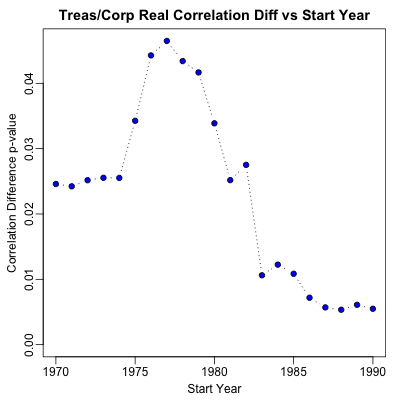
- First, it’s statistically significant (below 5%) for this whole era!
- In the early 1970’s, it’s about 2.5%. If we had accidentally chosen those years as a starting point, we’d be tempted to claim statistical significance: Treasuries were less correlted with stocks than corporates. (And then nisiprius would have come by to let the air out of our tires, which would have been a valuable service.)
- In 1976 - 1982, something reversed that: corporates and Treasuries were still differently correlated to stocks, but the statistical significance waned a bit (not completely!). No idea why, but the high inflation of those years seems a suspect.
- In 1983 - 1990, the effect reversed. (This is about the time Volker raised interest rates to the moon and broke the back of systematic inflation in the US. Recall, though, that these are real, post-inflation returns.) Choosing any time after about 1983 is a slam-dunk: the data through 2020 clearly indicate that Treasuries are a better diversifier than corporates, and the statistical significance is excellent, at p≤0.01!
The Weekend Conclusion
Well… what a long strange trip it’s been!
- We looked at data on return from a total stock market index fund, an intermediate-term Treasury bond index fund, and an intermediate-term corporate bond index fund.
- Using the (largely synthetic) data going back to 1871, we found that the evidence was mostly statistically significant pointing to Treasuries as a better stock diversifier. The exception was the difference in correlations with corporates.
- Looking at more modern eras, we saw that things had changed: everything was statistically significant in saying Treasuries were the better stock diversifier.
- The regressions support a model saying intermediate corporates are a bit like a Treasury bond with a small slice of the stock market. You cannot diversify stock market risk with more stock market risk.
So our 60/40 portfolio is 40% bonds, divided equally among:
- VSBSX, the Vanguard short-term Treasury index fund,
- VSIGX, the Vanguard intermediate-term Treasury index fund,
- VTAPX, the Vanguard short-term TIPS fund, and
- VTABX, the Vanguard international bond index fund. (This is mostly government bonds of developed nations. It hedges currency back to the dollar. So it looks a lot like US Treasuries. The best evidence Vanguard could present (see Fig 7 on p. 10: note the broad, shallow optimum where the portfolio variance changes by only 0.2% as foreign bonds go from 0% to 100%!) said it might not help much, but it at least wouldn’t hurt, and it’s one of the world’s largest asset classes. I decided to take their advice.)
Larry Swedroe, a principal at Buckingham Strategic Wealth and occasional contributor to Bogleheads, came to this conclusion some years before me (and indeed motivated me to think this through). He looked at portfolio-level effects of mixing corporates or Treasuries with stocks, and showed that Treasuries give better Sharpe ratios. [4] [5]
I took a slightly different route, but reached the same conclusion: Treasuries, not corporates.
Notes & References
1: Bogleheads community, “Simba backtesting spreadsheet”, Bogleheads.org, data snapshot 2021-Jun-01.↩
2: Weekend Editor, “Corporate vs Treasury analysis script in R”, Some Weekend Reading blog, 2021-Jun-07. There is also available, for peer review, a transcript of running the analysis.↩
3: Weekend Editor, “US Stock, Treasury, and Corporate Bond Returns 1871 - 2020”, Some Weekend Reading blog, 2021-Jun-07. Note that this contains both nominal and real returns. Since real returns are what really matters, we haven’t made much use of the nominal returns here. ↩
4: L Swedroe, “Swedroe: No Need For Corp. Bonds?”, ETF.com, 2018-May-18. ↩
5: L Swedroe, “Swedroe: Are Corp Bonds Worth Risk?”, ETF.com, 2018-Nov-28. ↩

Gestae Commentaria
Comments for this post are closed pending repair of the comment system, but the Email/Twitter/Mastodon icons at page-top always work.